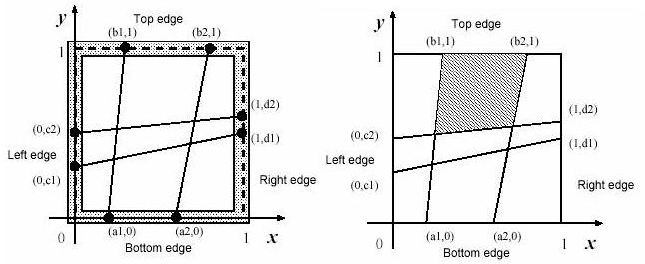标签:
| Time Limit: 1000MS | Memory Limit: 10000K | |
| Total Submissions: 1853 | Accepted: 1185 |
Description

Input
Output
Sample Input
2 0.2000000 0.6000000 0.3000000 0.8000000 0.1000000 0.5000000 0.5000000 0.6000000 2 0.3333330 0.6666670 0.3333330 0.6666670 0.3333330 0.6666670 0.3333330 0.6666670 4 0.2000000 0.4000000 0.6000000 0.8000000 0.1000000 0.5000000 0.6000000 0.9000000 0.2000000 0.4000000 0.6000000 0.8000000 0.1000000 0.5000000 0.6000000 0.9000000 2 0.5138701 0.9476283 0.1717362 0.1757412 0.3086521 0.7022313 0.2264312 0.5345343 1 0.4000000 0.6000000 0.3000000 0.5000000 0
Sample Output
0.215657 0.111112 0.078923 0.279223 0.348958
题意:如图,求图中面积最大的多边形的面积
思路:直接枚举i,j,求交点得到多边形的四个点,叉积法求面积

/** * Start at 21:20 * End at 22:40 * Problem: poj1408 * Author: __560 * */ #include<iostream> #include<cstdlib> #include<cstdio> #include<cstring> #include<algorithm> #include<math.h> using namespace std; const int maxn=1000100; const int INF=(1<<28); const double eps=0.00000000001; int n; struct Point { double x,y; friend double operator*(Point A,Point B) { return A.x*B.y-A.y*B.x; } friend Point operator-(Point A,Point B) { return {A.x-B.x,A.y-B.y}; } friend Point operator+(Point A,Point B) { return {A.x+B.x,A.y+B.y}; } }; Point A[maxn],B[maxn],C[maxn],D[maxn]; Point inter_point(Point A,Point B,Point C,Point D) { double a=fabs((B-A)*(C-A)); double b=fabs((B-A)*(D-A)); double x=(a*D.x+b*C.x)/(a+b); double y=(a*D.y+b*C.y)/(a+b); return {x,y}; } void solve() { double ans=0; A[0]=C[0]={0,0}; B[0]=C[n+1]={0,1}; D[0]=A[n+1]={1,0}; B[n+1]=D[n+1]={1,1}; for(int i=0;i<=n;i++){ for(int j=0;j<=n;j++){ Point a=inter_point(A[i],B[i],C[j],D[j]); Point b=inter_point(A[i+1],B[i+1],C[j],D[j]); Point c=inter_point(A[i],B[i],C[j+1],D[j+1]); Point d=inter_point(A[i+1],B[i+1],C[j+1],D[j+1]); double area=(b-a)*(d-a)/2.0+(d-a)*(c-a)/2.0; if(area>ans+eps) ans=area; //cout<<"a= "<<a.x<<" "<<a.y<<" "; //cout<<"i="<<i<<" j="<<j<<" area="<<area<<endl; } } printf("%.6f\n",ans); } int main() { while(cin>>n,n){ for(int i=1;i<=n;i++){ scanf("%lf",&(A[i].x)); A[i].y=0; } for(int i=1;i<=n;i++){ scanf("%lf",&(B[i].x)); B[i].y=1; } for(int i=1;i<=n;i++){ scanf("%lf",&(C[i].y)); C[i].x=0; } for(int i=1;i<=n;i++){ scanf("%lf",&(D[i].y)); D[i].x=1; } solve(); } return 0; }
标签:
原文地址:http://www.cnblogs.com/--560/p/4388672.html